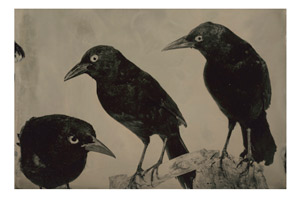Kimura Gallery features 'Imagining Fauna' through Feb. 10, 2012
by Kathleen McCoy |
 Jan. 18-Feb. 10
Jan. 18-Feb. 10
Monday-Friday, 10 a.m.-5 p.m.
Fine Arts Building, Kimura Gallery
Photography invites us to pay attention. It describes with economy, precision and detail. It enables us to stare, scrutinize and become voyeurs. Taxidermy allows us to do the same. Its complete replication of an animal's stance, gesture and look provides us a way to study and comprehend its existence. Yet I find that these animals, often portrayed in suspended animation, seem simultaneously strange, ghostly and beautiful. Their gaze is both familiar and unknown. I intend this work to move beyond what is merely seen to the territory of the imagination, where what is remembered and known is transformed into something new.
-- Mary Frey, 2011
The current exhibition, "Imagining Fauna," is a project that Frey began working on in 2008. Her book, Imagining Fauna, was published in August of 2009. She has produced six bodies of work beginning in 1979 with Domestic Rituals (1979-83). The other series she has produced over the years are Real Life Dramas (1984-87), Body/Parts (1989-91), Unsighted (1992-93), Telling Stories (1997-2001) and Family, Friends And Strangers (2002-2006). Frey's work is represented by Gallery 291 in San Francisco. All of her projects can be viewed at www.maryfrey.com.
Bio
Mary Frey received her MFA in photography from Yale University in 1979. Since then, she has been on the faculty of the Hartford Art School and is currently Professor of Photography. Frey received numerous awards for her work, most notably a Guggenheim Fellowship in 1984 and two photography fellowships from the National Endowment for the Arts in 1980 and 1992.
Notes on my use of the ambrotype process
Aging biological collections housed in science museums worldwide are facing a dilemma. Many specimens are deteriorating due not only to the ravages of time wrought by display and storage, but also from the tactics employed to preserve these specimens in the first place. The fragility of an ambrotype's glass substrate, coupled with the vagaries of this 19th-century printing process, appears to echo this visible evidence. The resultant objects seem an apt metaphor for our contemporary world, as nature and civilization struggle to find their proper balance for survival.
Technical notes
An ambrotype is a photographic image on blackened glass. It is created using the wet plate collodion process, which was popular in the mid-19th century. A glass plate is coated with collodion, sensitized in a silver nitrate bath and, while still wet, exposed in camera. The image is then developed and fixed on the glass. When backed with black, it appears positive and a final coat of varnish is applied to protect it.
I have created these images utilizing this wet plate process in conjunction with 21st century technologies. I mixed my chemistry as the early practitioners did, employing all their application techniques and procedures. However, I shot the original photographs with a digital camera. I then converted these digital files to 4x5, black and white transparencies and exposed them in an enlarger onto black glass.
 "Kimura Gallery features 'Imagining Fauna' through Feb. 10, 2012" is licensed under a Creative Commons Attribution-NonCommercial 4.0 International License.
"Kimura Gallery features 'Imagining Fauna' through Feb. 10, 2012" is licensed under a Creative Commons Attribution-NonCommercial 4.0 International License.









